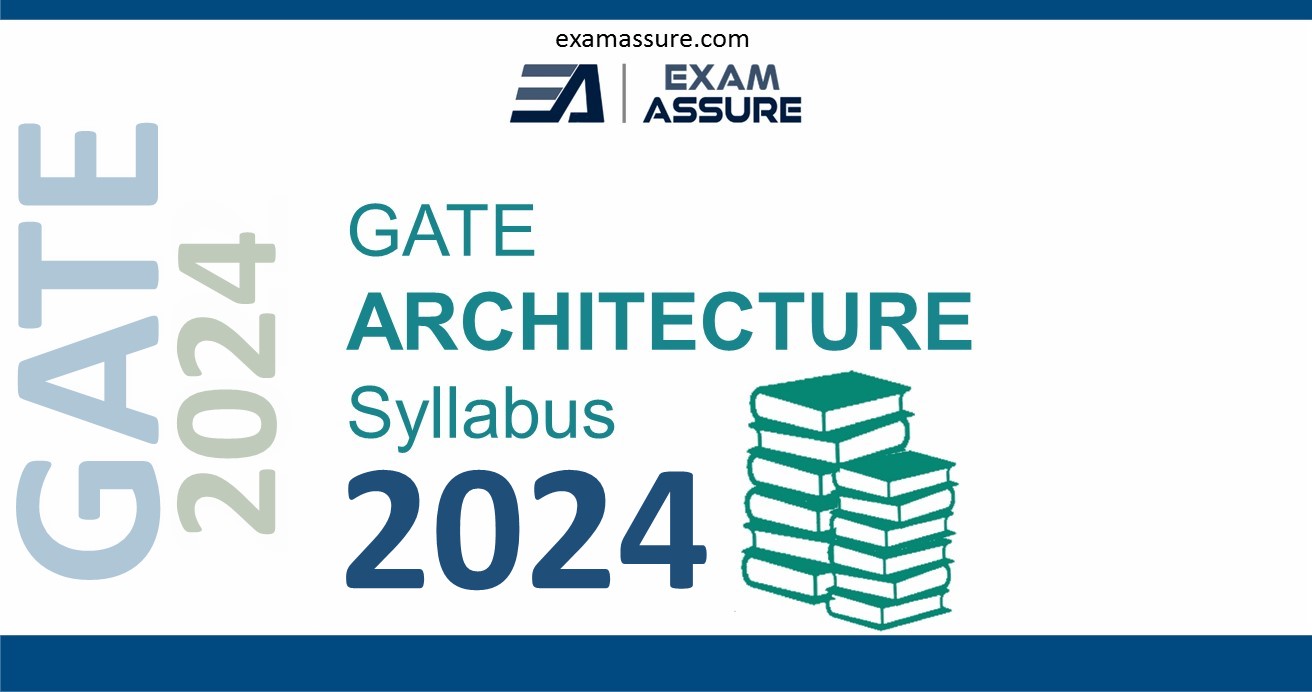Exam Assure updates regularly on WhatsApp
Join WhatsApp Group
Join us on Social media:

GATE Architecture Syllabus 2023 | GATE Architecture and Planning Syllabus 2024 | GATE AR & PL Latest Syllabus 2024
The GATE Architecture and Planning Paper Consists of 02 Sections, General Aptitude (15 Marks) and Technical Section (Architecture and Planning) (85 Marks). Technical Section is divided into two parts; Part A: Common and Part B, further Part B is divided into 02 different parts i.e. Part B1: Architecture and Part B2: Planning.
Part A is common for all candidates however Candidates will get the option to choose from
Part B1: Architecture and Part B2: Planning.
| S.No. | Section: | Total Marks: |
| 1. | General Aptitude | 15 Marks |
| 2. | Technical Section (Architecture and Planning) | 85 Marks |
| Total Marks: | 100 Marks |
Syllabus Overview of GATE AR 2024
A. General Aptitude
1. Verbal Aptitude
2. Quantitative Aptitude
3. Analytical Aptitude
4. Spatial Aptitude
AR. Architecture and Planning
Part A: Common
Section 1: Architecture, Planning and Design
Section 2: Construction and Management
Section 3: Environmental Planning and Design
Section 4: Urban Design, Landscape and Conservation
Section 5: Planning process
Section 6: Housing
Section 7: Services and Infrastructure
Part B1: Architecture
Section B1.1: History and Contemporary Architecture
Section B1.2: Building Construction and Structural systems
Section B1.3: Building Services and Sustainability
Part B2: Planning
Section B2.1: Regional and Settlement Planning
Section B2.2: Planning Techniques and Management
Section B2.3: Infrastructure Planning
Detailed Syllabus of GATE 2024
A. General Aptitude
1. Verbal Aptitude
Basic English grammar: tenses, articles, adjectives, prepositions, conjunctions, verb-nounagreement, and other parts of speech Basic vocabulary: words, idioms, and phrases incontext Reading and comprehension Narrative sequencing
2. Quantitative Aptitude
Data interpretation: data graphs (bar graphs, pie charts, and other graphs representingdata), 2-and 3-dimensional plots, maps, and tables Numerical computation and estimation: ratios,percentages, powers, exponents and logarithms, permutations and combinations, andseriesMensuration and geometry Elementary statistics and probability
3. Analytical Aptitude
Logic: deduction and induction, Analogy, Numerical relations and reasoning
4. Spatial Aptitude
Transformation of shapes: translation, rotation, scaling, mirroring, assembling, and grouping Paper folding, cutting, and patterns in 2 and 3 dimensions
AR. Architecture and Planning
Part A: Common
Section 1: Architecture, Planning and Design
Architectural Graphics; Visual composition in 2D and 3D; Computer application in Architecture and Planning; Anthropometrics; Organization of space; Circulation- horizontal and vertical; Space Standards; Universal design; Building byelaws; Codes and standards;
Section 2: Construction and Management
Project management techniques e.g. PERT, CPM etc.; Estimation and Specification; Professional practice and ethics; Form and Structure; Principles and design of disaster resistant structures; Temporary structures for rehabilitation;
Section 3: Environmental Planning and Design
Natural and man-made ecosystem; Ecological principles; Environmental considerations in Planning and design; Environmental pollution- types, causes, controls and abatement strategies; Sustainable development, goals and strategies; Climate change and built environment; Climate responsive design;
Section 4: Urban Design, Landscape and Conservation
Historical and modern examples of urban design; Elements of urban built environment – urban form, spaces, structure, pattern, fabric, texture, grain etc.; Concepts and theories of urban design; Principles, tools and techniques of urban design; Public spaces, character, spatial qualities and Sense of Place; Urban design interventions for sustainable development and transportation; Development controls – FAR, densities and building byelaws.; Urban renewal and conservation; heritage conservation; historical public spaces and gardens; Landscape design; Site planning;
Section 5: Planning process
Salient concepts, theories and principles of urban planning; concepts of cities – Eco-City, Smart City; Concepts and theories by trendsetting planners and designers; Ekistics; Urban sociology; Social, Economic and environmental cost benefit analysis; Methods of non-spatial and spatial data analysis; Development guidelines such as URDPFI;
Section 6: Housing
Housing typologies; Concepts, principles and examples of neighbourhood; Residential densities; Affordable Housing; Real estate valuation;
Section 7: Services and Infrastructure
Firefighting Systems; Building Safety and Security systems; Building Management Systems; Water treatment; Water supply and distribution system; Water harvesting systems; Principles, Planning and Design of storm water drainage system; Sewage disposal methods; Methods of solid waste management – collection, transportation and disposal; Recycling and Reuse of solid waste; Land-use – transportation – urban form inter-relationships; Design of roads, intersections, grade separators and parking areas; Hierarchy of roads and level of service; Para-transits and other modes of transportation, Pedestrian and slow moving traffic planning;
Part B1: Architecture
Section B1.1: History and Contemporary Architecture
Principles of Art and Architecture; World History of Architecture: Egyptian, Greco-Roman classical period, Byzantine, Gothic, Renaissance, Baroque-Rococo, etc.; Recent trends in Contemporary Architecture: Art nouveau, Art Deco, Eclecticism, International styles, Post Modernism, Deconstruction in architecture, etc.; Influence of Modern art and Design in Architecture; Indian vernacular and traditional Architecture, Oriental Architecture; Works of renowned national and international architects;
Section B1.2: Building Construction and Structural systems
Building construction techniques, methods and details; Building systems and prefabrication of building elements; Principles of Modular Coordination; Construction planning and equipment; Building material characteristics and applications; Principles of strength of materials; Alternative building materials; Foundations; Design of structural elements with different materials; Elastic and Limit State design; Structural systems; Principles of Pre-stressing; High Rise and Long Span structures, gravity and lateral load resisting systems;
Section B1.3: Building Services and Sustainability
Solar architecture; Thermal, visual and acoustic comfort in built environments; Natural and Mechanical ventilation in buildings; Air-Conditioning systems; Sustainable building strategies; Building Performance Simulation and Evaluation; Intelligent Buildings; Water supply; Sewerage and drainage systems; Sanitary fittings and fixtures; Plumbing systems; Principles of internal and external drainage system; Principles of electrification of buildings; Elevators and Escalators – standards and uses;
Part B2: Planning
Section B2.1: Regional and Settlement Planning
Regional delineation; settlement hierarchy; Types and hierarchy of plans; Various schemes and programs of central government; Transit Oriented Development (TOD), SEZ, SRZ etc.; Public Perception and user behaviour; National Housing Policies, Programs and Schemes.; Slums, Squatters and informal housing; Standards for housing and community facilities; Housing for special areas and needs;
Section B2.2: Planning Techniques and Management
Application of G.I.S and Remote Sensing techniques in urban and regional planning; Tools and techniques of Surveys – Physical, Topographical, Land use and Socio-economic Surveys; Urban Economics, Law of demand and supply of land and its use in planning; Graphic presentation of spatial data; Local self-governance, Panchayatiraj institutions; Planning Legislation and implementation – Land Acquisition Act, PPP etc.; Decision support system and Land Information System; Urban geography and econometrics; Management of Infrastructure Projects; Demography and equity in planning;
Section B2.3: Infrastructure Planning
Process and Principles of Transportation Planning and Traffic Engineering; Road capacity and Travel demand forecasting; Traffic survey methods, Traffic flow Analysis; Traffic analyses and design considerations; Traffic and transport management and control in urban areas; Mass transportation planning; Intelligent Transportation Systems; Urban and Rural Infrastructure System Network.
New Batch
Join Today
Hope you liked this
Recent Government Jobs:
- Vacancy for Program Associate at National Institute of Urban Affairs (NIUA) | New Delhi (Last Date: 02 August 2024)
- Vacancy for Multiple Positions (Sr. Planner, Director, Executive Engineer, etc.) at Andhra Pradesh Capital Region Development Authority | Vijayawada (Last Date: 9th August 2024)
- Vacancy for Faculty Positions at Dr. R. S. Tolia Uttarakhand Academy of Administration(ATI) | Uttarakhand (Last Date: 08 August, 2024)
- Vacancy for Multiple Positions (Project Associate, Project Assistant, etc.) at CSIR-CENTRAL BUILDING RESEARCH INSTITUTE | Roorkee (Walk-in-Interview: 05, 06, 12, 13, 14 & 16 August 2024)
Visit Exam Assure Jobs Section to explore similar Jobs:
Disclaimer: The Job posts/ Job vacancies updated on the Exam Assure platform are gathered from various sources. Exam Assure team tries their best to display correct information as far as possible however there is a chance of mistakes. Visitors are suggested to cross-verify all the information before applying.








